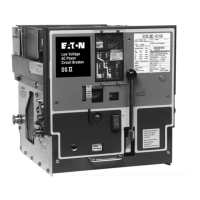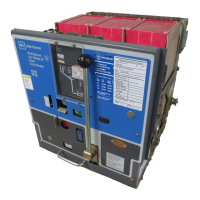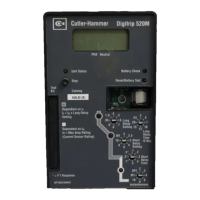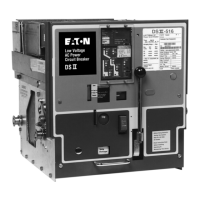I.
B.
694C694-02
Figure 4-15 shows the parts relationship for padlocking
in
the trip-free shutter up condition. The three major
parts are interleaved and assembled on the left hand
side of the levering device assembly.
1. Shutter
2. Trip Plate
3. Padlock Interlock Lever
The padlock interlock lever is located between the trip
plate and padlock plate. It is pivoted on a fixed center
toward the rear of the breaker. The front part of this
lever has a sloping slot in which a projection from the
CD
Padlock Plat Notch
® Padlock Plate
@Trip
Plate
@ Front Panel
®Shutter
@ Levering Device Worm Shaft
(j) Projection
on
Shutter
® Bent Tab
on
Padlock Plate
® Projection
on
Trip Plate
@ Padlock Interlock Lever
@ Pin
on
Padlock Interlock Lever
@Trip
Shaft
Figure 4-15 Padlock Device (Locked Trip-Free with
Shutter Raised)
Effective
07
/97
Page
41
trip plate extends. Horizontal movement of the trip plate
by cam action of the projection against the walls of the
slot causes the front of the interlock lever to move up
or
down. The interlock lever is pushed upward by a spring.
This lever also has a short pin extending outward, nor-
mally into a curved notch
in
the bottom edge of the pad-
lock plate.
To padlock the breaker with the shutter closed, push the
trip plate
in
and pull the padlock plate forward. This
exposes the padlock slot
in
the padlock plate. Insert the
padlock and lock.
Movement of the trip plate pushes the front end of the
padlock interlock lever down, moving its pin downward
and out of the notch
in
the padlock plate. Forward
movement of the padlock plate and backward move-
ment of the trip plate places the pin in the padlock inter-
lock lever behind the notch
in
the padlock plate. With
the padlock plate held forward, the padlock interlock
lever cannot move. Consequently, the projection from
the trip plate is held
in
the slot
in
the padlock interlock
lever. This holds the breaker locked in the trip-free con-
dition until the padlock is removed and the members are
returned to their normal positions by return springs.
While locked, the shutter is prevented from downward
travel by a horizontal projection striking a bent over tab
on the padlock plate.
4-6 DSLll CIRCUIT BREAKER AND FUSE TRUCK
An overall description of Type DSLll Circuit Breakers
and Fuse Trucks is provided
in
Section 3 (Figure
3-2). More detailed information is provided here relative
to application, operation, replacement and installation.
Table
4.1
outlines the available limiters recommended
for use with DSLll circuit breakers.
If current limiters are sized
in
keeping with Table
4.1
rec-
ommendations, the circuit breaker will function and inter-
rupt routine fault currents. Infrequent high faults are
cleared by the limiters. The limiters protect the circuit
breaker
on
faults above the rating of the breaker. The lim-
iters will blow below the circuit breaker short-time rating, if
the fault currents equal the system maximum capacity.
In
some applications the current limiters are sized small-
er
than necessary for protection of the DSLll circuit
breaker
in
order to provide protection for downstream
equipment. When this is done, the current limiters will
blow
on
fault currents which could have been satisfacto-
rily interrupted by the basic circuit breaker.
Type DSll-FT32 and DSll-FT40 fuse trucks provide for
separate mounting of current limiting fuses on drawout
Courtesy of NationalSwitchgear.com

